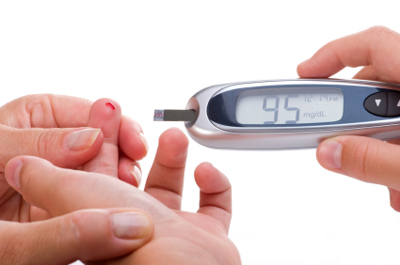Diabetes mellitus has been recognized as a clinical syndrome since ancient times and remains a crippling global health problem today. When the amount of glucose in the blood increases, e.g., after a meal, it stimulates the release of the insulin hormone from the pancreas.
Insulin stimulates muscle and fat cells to remove glucose from the blood and stimulates the liver to metabolize glucose and decrease the blood sugar level to normal level. An estimated 1.2 billion people in the world are overweight with 300 million of them being obese. According to Wild et al India is the top most country with maximum people with diabetes in 2000 (31.7 million) and prediction for 2030 is 79.4 million, just more than double. Followed by China, where people with diabetes were 20.8 million in 2000 and estimated escalated value is 42.7 million in 2030. Diabetes mellitus is a group of metabolic disease symptoms characterized by hyperglycemia resulting from defects in insulin secretion, insulin action, or both (Expert Committee on the Diagnosis and Classification of Diabetes Mellitus, 2003).
Around 250 B.C., the name “diabetes” was first used. It is a Greek word that means “to syphon”, reflecting how diabetes seemed to rapidly drain fluid from the affected individual. It is the most common of the serious metabolic diseases. Physicians have observed the effects of diabetes for thousands of years. For much of this time, little was known about this fatal disease that caused wasting away of the body, extreme thirst, and frequent urination. Ancient Hindu writings, many thousands of years old, document how black ants and flies were attracted to the urine of diabetics. The Indian physician Sushruta in 400 B.C. described the sweet taste of urine from affected individuals, and for many centuries to come, the sweet taste of urine was key to diagnosis. Diabetes Mellitus is known to Indians from Vedic period onwards by the name Asrava (Prameha). Diabetes is also known as Madhumeha (means passing sweet urine) in Ayurveda.
1869 Paul Langerhans, a German medical student, announces in a dissertation that the pancreas contains contains two systems of cells. One set secretes the normal pancreatic juice, the function of the other was unknown. Several years later, these cells are identified as the ‘islets of Langerhans.’
|
1552 B.C. |
Earliest known record of diabetes mentioned on 3rd Dynasty Egyptian papyrus by physician Hesy-Ra; mentions polyuria (frequent urination) as a symptom. |
|
400 B.C. |
The Indian physician Sushruta in 400 B.C. described the sweet taste of urine from affected individuals, and for many centuries to come, the sweet taste of urine was key to diagnosis. |
|
250 B.C |
The name “diabetes” was first used. It is a Greek word that means “to syphon”, reflecting how diabetes seemed to rapidly drain fluid from the affected individual. |
|
1st Century A.D. |
Diabetes described by Arateus as ‘the melting down of flesh and limbs into urine.’ |
|
1st Century A.D. |
Diabetes described by Arateus as ‘the melting down of flesh and limbs into urine.’ |
|
Up to 11th Century |
Diabetes commonly diagnosed by ‘water tasters,’ who drank the urine of those suspected of having diabetes; the urine of people with diabetes was thought to be sweet-tasting. The Latin word for honey (referring to its sweetness), ‘mellitus’, is added to the term diabetes as a result. |
|
1674 |
“Diabetes mellitus” was coined by Thomas Willis, personal physician to King Charles II. Mellitus is Latin for honey, which is how Willis described the urine of diabetics (“as if imbued with honey and sugar”). |
|
Early 19th Century |
First chemical tests developed to indicate and measure the presence of sugar in the urine. |
|
1870s |
French physician, Bouchardat, notices the disappearance of glycosuria in his diabetes patients during the rationing of food in Paris while under siege by Germany during the Franco-Prussian War; formulates idea of individualized diets for his diabetes patients. |
|
1889 |
A breakthrough in the puzzle of diabetes came German physicians Joseph von Mering and Oskar Minkowski surgically removed the pancreas from dogs. The dogs immediately developed diabetes. Now that a link was established between the pancreas gland and diabetes, research focused on isolating the pancreatic extract that could treat diabetes. |
|
1900-1915 |
‘Fad’ diabetes diets include: the ‘oat-cure’ (in which the majority of diet was made up of oatmeal), the milk diet, the rice cure, ‘potato therapy’ and even the use of opium! |
|
1919 |
Frederick Allen publishes Total Dietary Regulation in the Treatment of Diabetes, citing exhaustive case records of 76 of the 100 diabetes patients he observed, becomes the director of diabetes research at the Rockefeller Institute. |
|
1910-1920 |
Frederick Madison Allen and Elliot P. Joslin emerge as the two leading diabetes specialists in the United States. Joslin believes diabetes to be ‘the best of the chronic diseases’ because it was ‘clean, seldom unsightly, not contagious, often painless and susceptible to treatment.’ |
|
1921 |
Insulin is ‘discovered’. A de-pancreatized dog is successfully treated with insulin. |
|
1923 |
Banting and Macloed were awarded the Nobel Prize for the discovery of insulin. |
|
1944 |
Standard insulin syringe is developed, helping to make diabetes management more uniform. |
|
1959 |
Two major types of diabetes are recognized: type 1 (insulin-dependent) diabetes and type 2 (non-insulin-dependent) diabetes. |
|
1983 |
First biosynthetic human insulin is introduced. |
|
1998 |
The United Kingdom Prospective Diabetes Study (UKPDS) is published. UKPDS results clearly identify the importance of good glucose control and good blood pressure control in the delay and/or prevention of complications in type 2 diabetes. |
